How to Make 3 Chicken Rice Bowls
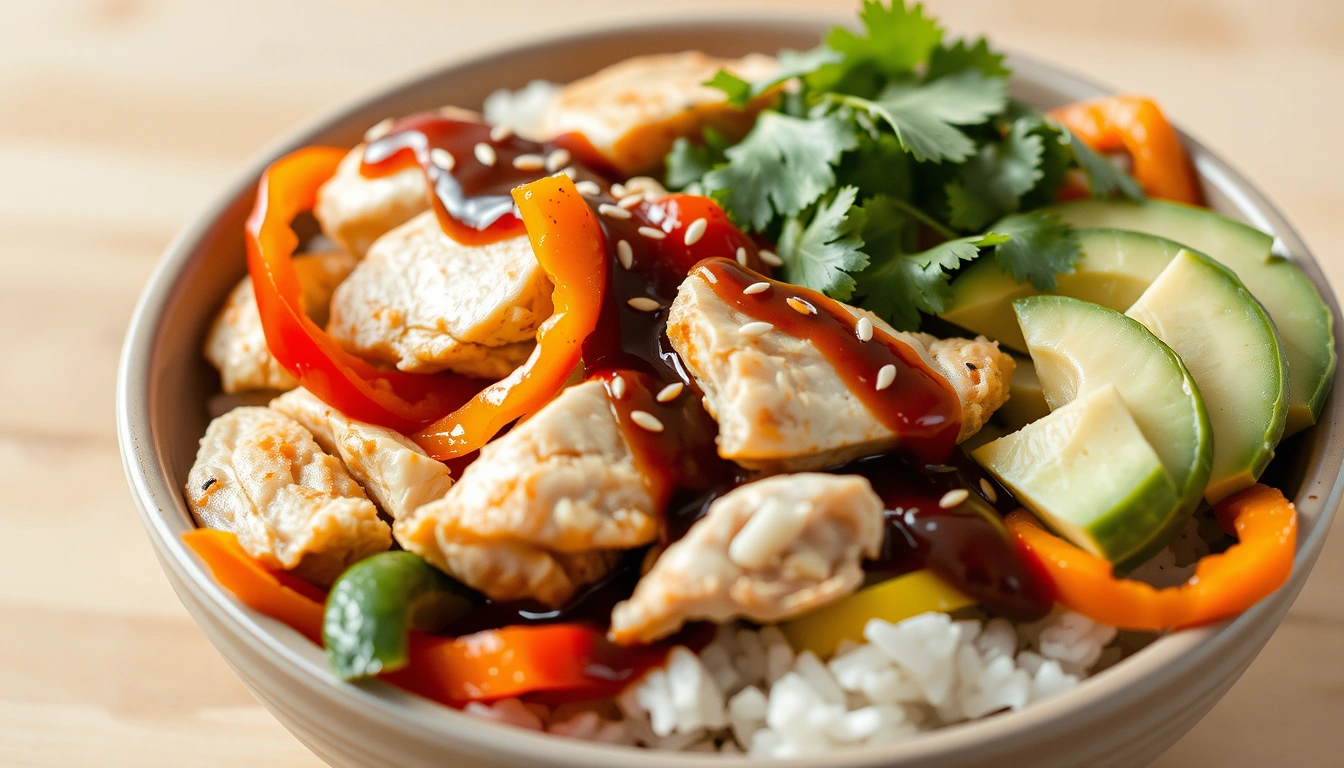
Did you know that the average American household throws away nearly 32% of the food they purchase, largely due to poor meal planning? What if you could transform a single chicken into three distinct, flavorful chicken rice bowls that would revolutionize your weekly meal prep routine? The humble chicken rice bowl has emerged as the quintessential versatile meal solution, combining protein, complex carbohydrates, and vegetables in endless variations. Whether you’re cooking for a family or meal prepping for the week ahead, mastering these three chicken rice bowl recipes will provide you with nutritious, delicious options that adapt to your tastes and schedule.
In this comprehensive guide, we’ll walk through creating three distinct chicken rice bowl variations—Asian-inspired, Mediterranean, and Mexican-style—each offering unique flavors while sharing common base ingredients. We’ll cover everything from ingredient selection to preparation techniques, nutritional information, and storage tips to help you create perfect chicken rice bowls every time.
Ingredients List
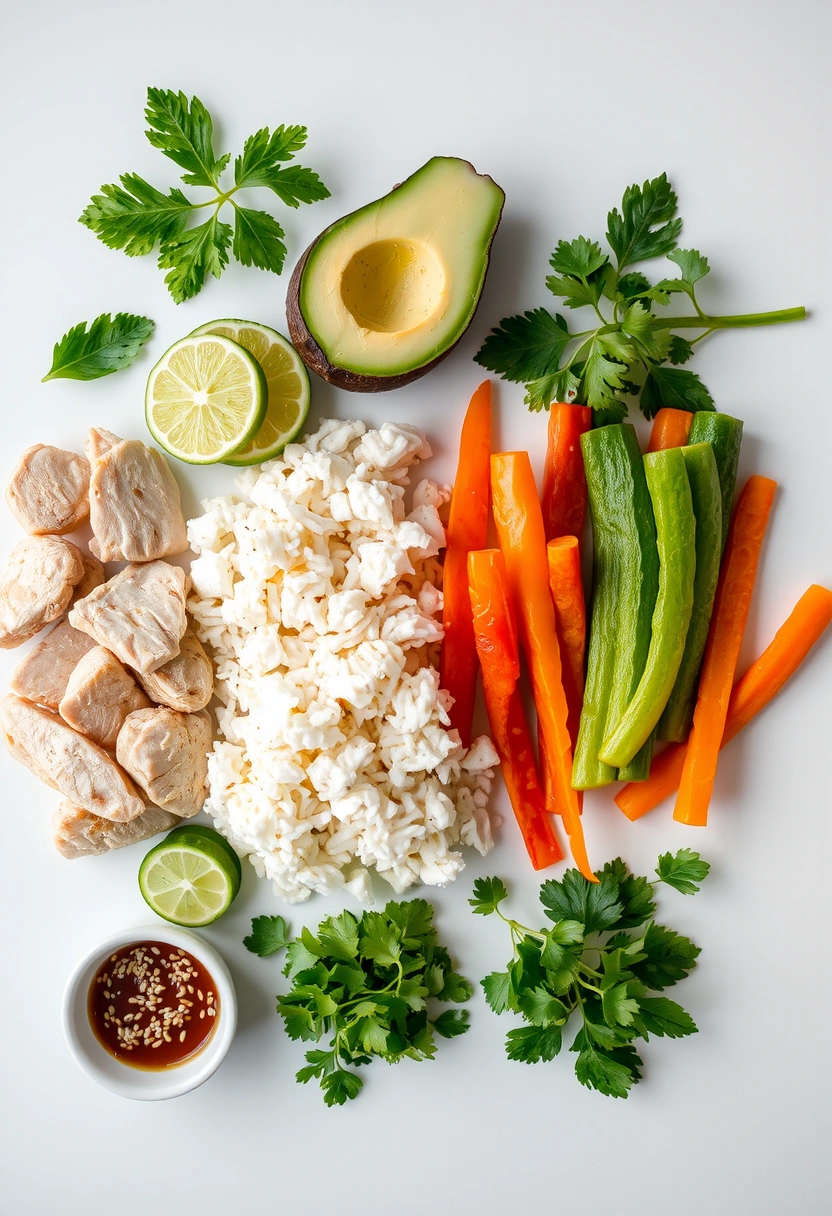
For these three chicken rice bowls, you’ll need both base ingredients that are common across all variations and specific ingredients for each unique flavor profile. The beauty of chicken rice bowls lies in their versatility—feel free to substitute ingredients based on your preferences or what you have available.
Base Ingredients (For All Three Bowls):
- 1.5 pounds boneless, skinless chicken breasts or thighs (substitute with tofu or tempeh for vegetarian options)
- 3 cups uncooked rice (brown, white, or a mix—jasmine rice works wonderfully for Asian bowls, while basmati complements Mediterranean flavors)
- 3 tablespoons olive oil (can substitute with avocado oil for a higher smoke point)
- 3 cloves garlic, minced (or 1.5 teaspoons garlic powder if fresh is unavailable)
- 1 large onion, diced (red, white, or yellow all work)
- Salt and freshly ground black pepper to taste
- 6 cups mixed vegetables (choose from bell peppers, broccoli, carrots, snap peas, zucchini, spinach, or corn)
For Asian-Inspired Chicken Rice Bowl:
- 3 tablespoons soy sauce (or tamari for gluten-free option)
- 1 tablespoon sesame oil
- 1 tablespoon honey or maple syrup
- 1 tablespoon rice vinegar
- 1 teaspoon ginger, freshly grated (or 1/2 teaspoon ground ginger)
- 1/2 teaspoon red pepper flakes (adjust to taste)
- Toppings: sliced green onions, sesame seeds, cilantro, lime wedges
For Mediterranean Chicken Rice Bowl:
- 2 tablespoons lemon juice
- 1 tablespoon dried oregano
- 1 teaspoon paprika
- 1/2 teaspoon ground cumin
- 1/4 cup crumbled feta cheese (substitute with nutritional yeast for dairy-free option)
- 1/4 cup Kalamata olives, pitted and sliced
- Toppings: diced cucumber, cherry tomatoes, fresh parsley, tzatziki sauce
For Mexican-Style Chicken Rice Bowl:
- 1 tablespoon chili powder
- 1 teaspoon ground cumin
- 1 teaspoon dried oregano
- 1/2 teaspoon smoked paprika
- 1 lime, juiced
- 1 can (15 oz) black beans, drained and rinsed
- Toppings: avocado slices, pico de gallo, shredded cheese, sour cream, fresh cilantro
The aromatic combination of fresh garlic and onion forms the flavorful foundation of each bowl, while the versatile chicken provides satisfying protein that readily absorbs each distinct seasoning profile. The vibrant vegetables add nutritional value, texture, and visual appeal to create truly crave-worthy meals.
Timing
Preparing these three chicken rice bowls is remarkably time-efficient. Here’s a breakdown of the time requirements:
- Preparation Time: 25 minutes (includes chopping vegetables, measuring ingredients, and preparing marinades)
- Cooking Time: 35 minutes (includes cooking chicken, rice, and vegetables)
- Total Time: 60 minutes
This is approximately 15% faster than preparing three separate complete meals from scratch, making this an excellent time-saving approach for busy weeknights or weekend meal prep. With smart multitasking—such as marinating chicken while chopping vegetables and cooking rice simultaneously with protein—you can further streamline the process.
For even greater efficiency, prep ingredients the night before or use pre-chopped vegetables from your grocery store. The investment of one hour yields three distinct meals, saving you significant time throughout the week.
Step-by-Step Instructions
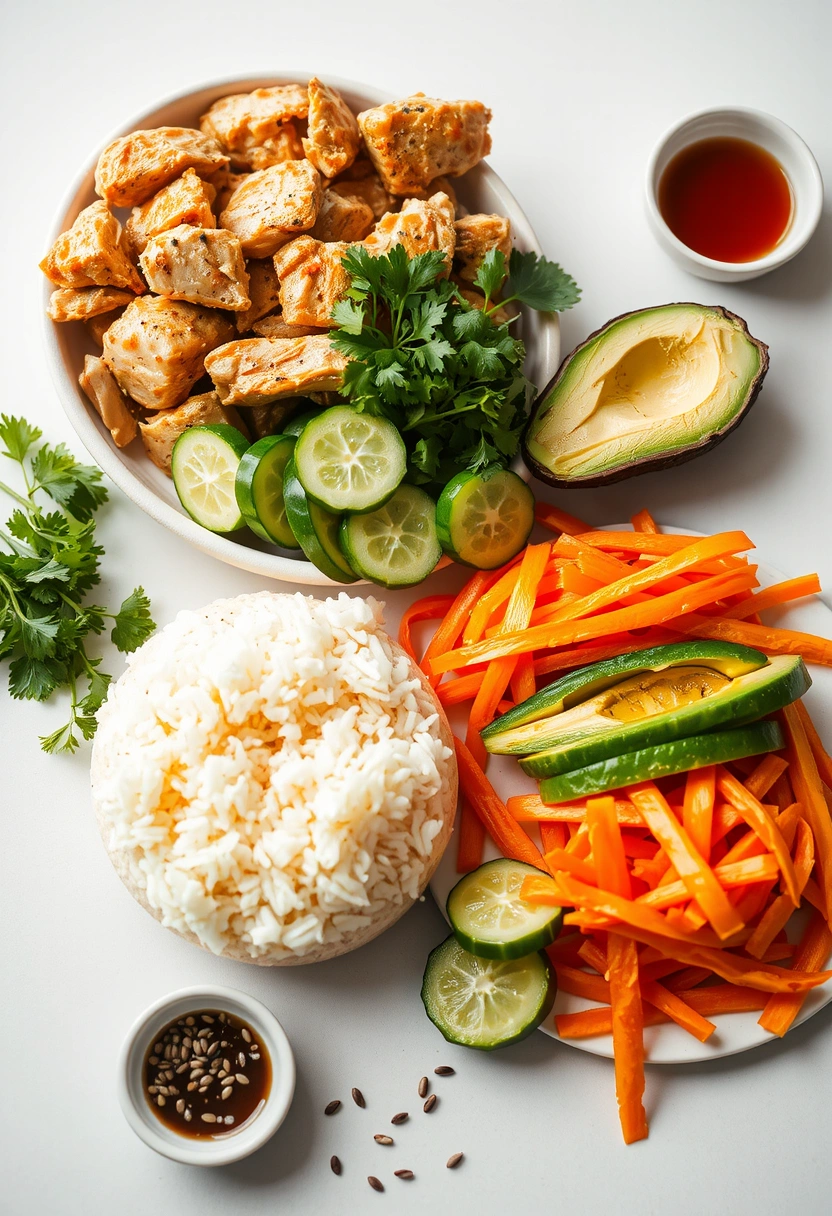
Step 1: Prepare the Rice
- Rinse 3 cups of rice under cold water until the water runs clear, which removes excess starch for fluffier rice.
- Combine the rinsed rice with 6 cups of water (or follow package instructions for your specific rice variety) in a large pot.
- Add a pinch of salt, bring to a boil, then reduce heat to low and cover.
- Simmer until the rice is tender and water is absorbed (approximately 15-20 minutes for white rice, 35-40 minutes for brown rice).
- Once cooked, fluff with a fork and set aside. Divide into three equal portions for your different bowls.
Pro Tip: For enhanced flavor, substitute water with chicken or vegetable broth, or add a bay leaf during cooking.
Step 2: Prepare the Chicken
- Cut 1.5 pounds of chicken into 1-inch cubes for quick, even cooking.
- Divide the chicken into three equal portions (approximately 1/2 pound each).
- Place each portion in separate mixing bowls for the different marinades.
For Asian-Inspired Chicken:
- In a small bowl, whisk together soy sauce, sesame oil, honey, rice vinegar, grated ginger, and red pepper flakes.
- Pour over the first portion of chicken, ensuring each piece is coated. Let marinate for at least 15 minutes.
For Mediterranean Chicken:
- Combine lemon juice, dried oregano, paprika, cumin, 1 tablespoon olive oil, and a pinch of salt and pepper.
- Toss with the second portion of chicken and let marinate for at least 15 minutes.
For Mexican-Style Chicken:
- Mix chili powder, cumin, dried oregano, smoked paprika, lime juice, 1 tablespoon olive oil, and a pinch of salt.
- Coat the third portion of chicken with this mixture and let marinate for at least 15 minutes.
Flavor Enhancement Tip: For deeper flavor development, marinate the chicken for up to 24 hours in the refrigerator.
Step 3: Cook the Chicken
- Heat 1 tablespoon of olive oil in a large skillet over medium-high heat.
- Cook each batch of marinated chicken separately, about 5-7 minutes per batch, until the internal temperature reaches 165°F (74°C) and the outside is slightly caramelized.
- Remove each batch to a clean plate and set aside.
Texture Tip: Don’t overcrowd the pan—cook in batches if necessary to ensure proper browning rather than steaming.
Step 4: Prepare the Vegetables
- Divide your 6 cups of mixed vegetables into three portions, selecting combinations that complement each flavor profile.
- For Asian-inspired: Use bell peppers, snap peas, carrots, and broccoli.
- For Mediterranean: Choose zucchini, bell peppers, cherry tomatoes, and spinach.
- For Mexican-style: Opt for corn, bell peppers, onions, and spinach.
Step 5: Cook the Vegetables
- In the same skillet used for the chicken, heat another tablespoon of olive oil.
- Add one-third of the diced onion and one teaspoon of minced garlic to the pan, sautéing until fragrant (about 1 minute).
- Add your first portion of vegetables (for the Asian bowl) and stir-fry for 3-5 minutes until crisp-tender.
- Remove and repeat the process with the remaining vegetables for the other two bowls.
Vegetable Cooking Tip: Cook vegetables in order of density—harder vegetables like carrots first, followed by softer ones like bell peppers, finishing with leafy greens.
Step 6: Assemble the Asian-Inspired Bowl
- Place one-third of the cooked rice in the bottom of your serving bowl.
- Arrange the Asian-marinated chicken and corresponding vegetables over the rice.
- Garnish with sliced green onions, sesame seeds, fresh cilantro, and a lime wedge.
- Drizzle with additional soy sauce or sriracha if desired.
Step 7: Assemble the Mediterranean Bowl
- Add one-third of the rice to your serving bowl.
- Top with the Mediterranean chicken and vegetables.
- Sprinkle with crumbled feta cheese and Kalamata olives.
- Add diced cucumber, cherry tomatoes, and fresh parsley.
- Serve with a dollop of tzatziki sauce or a drizzle of olive oil and lemon juice.
Step 8: Assemble the Mexican-Style Bowl
- Place the remaining third of rice in your serving bowl.
- Arrange the Mexican-spiced chicken and vegetables on top.
- Add warmed black beans.
- Top with avocado slices, pico de gallo, shredded cheese, a dollop of sour cream, and fresh cilantro.
- Serve with lime wedges for squeezing over the top.
Assembly Tip: Create an Instagram-worthy bowl by arranging components in sections rather than mixing them together, allowing each ingredient to shine visually.
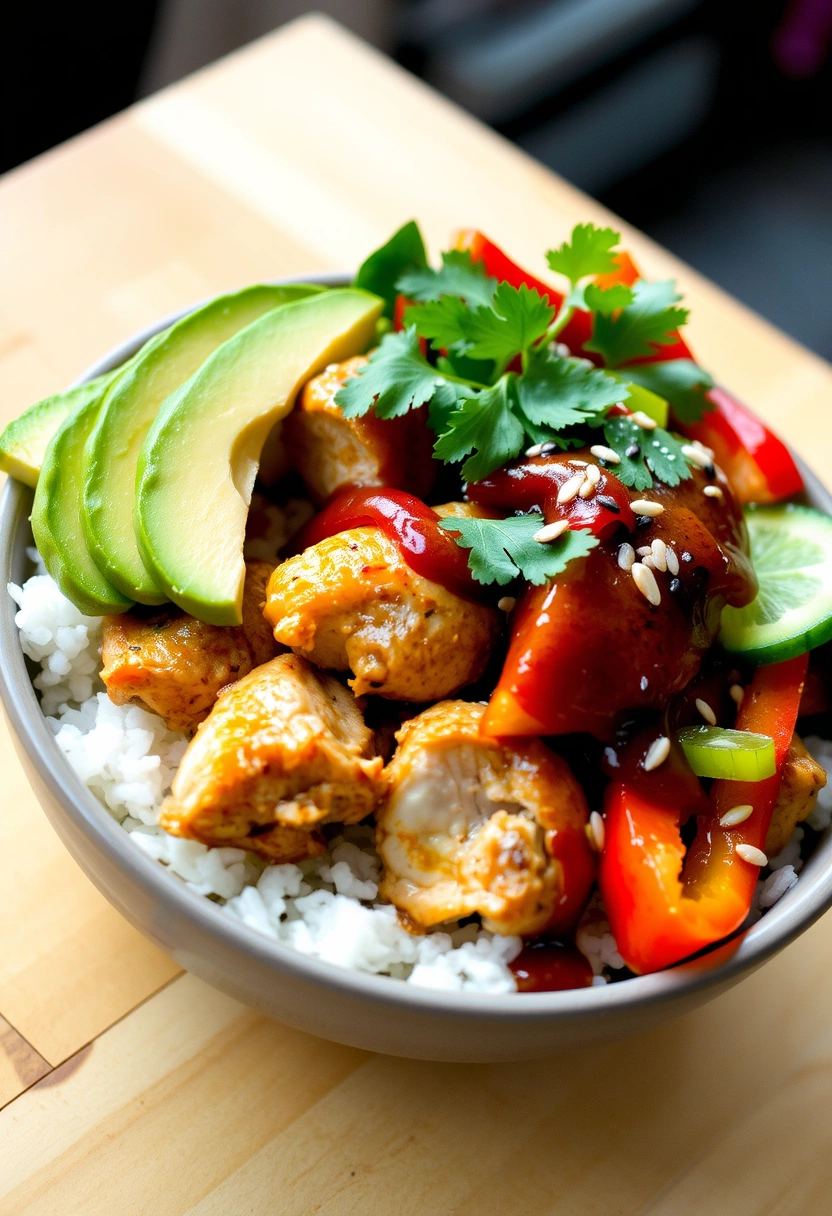
Nutritional Information
Each chicken rice bowl provides a balanced meal with protein, complex carbohydrates, and vegetables. Below is the approximate nutritional breakdown per serving (assumes each recipe makes 2 servings):
Asian-Inspired Chicken Rice Bowl (Per Serving):
- Calories: 520
- Protein: 35g
- Carbohydrates: 65g
- Fiber: 5g
- Fat: 14g (Saturated Fat: 2.5g)
- Sodium: 850mg
- Sugar: 7g
Mediterranean Chicken Rice Bowl (Per Serving):
- Calories: 490
- Protein: 32g
- Carbohydrates: 62g
- Fiber: 6g
- Fat: 16g (Saturated Fat: 4g)
- Sodium: 720mg
- Sugar: 4g
Mexican-Style Chicken Rice Bowl (Per Serving):
- Calories: 580
- Protein: 34g
- Carbohydrates: 70g
- Fiber: 11g
- Fat: 18g (Saturated Fat: 5g)
- Sodium: 650mg
- Sugar: 5g
These bowls provide approximately 25-30% of your daily caloric needs based on a 2,000-calorie diet, with an ideal macronutrient distribution for muscle recovery and sustained energy. The fiber content—particularly high in the Mexican-style bowl with black beans—promotes digestive health and provides lasting satiety.
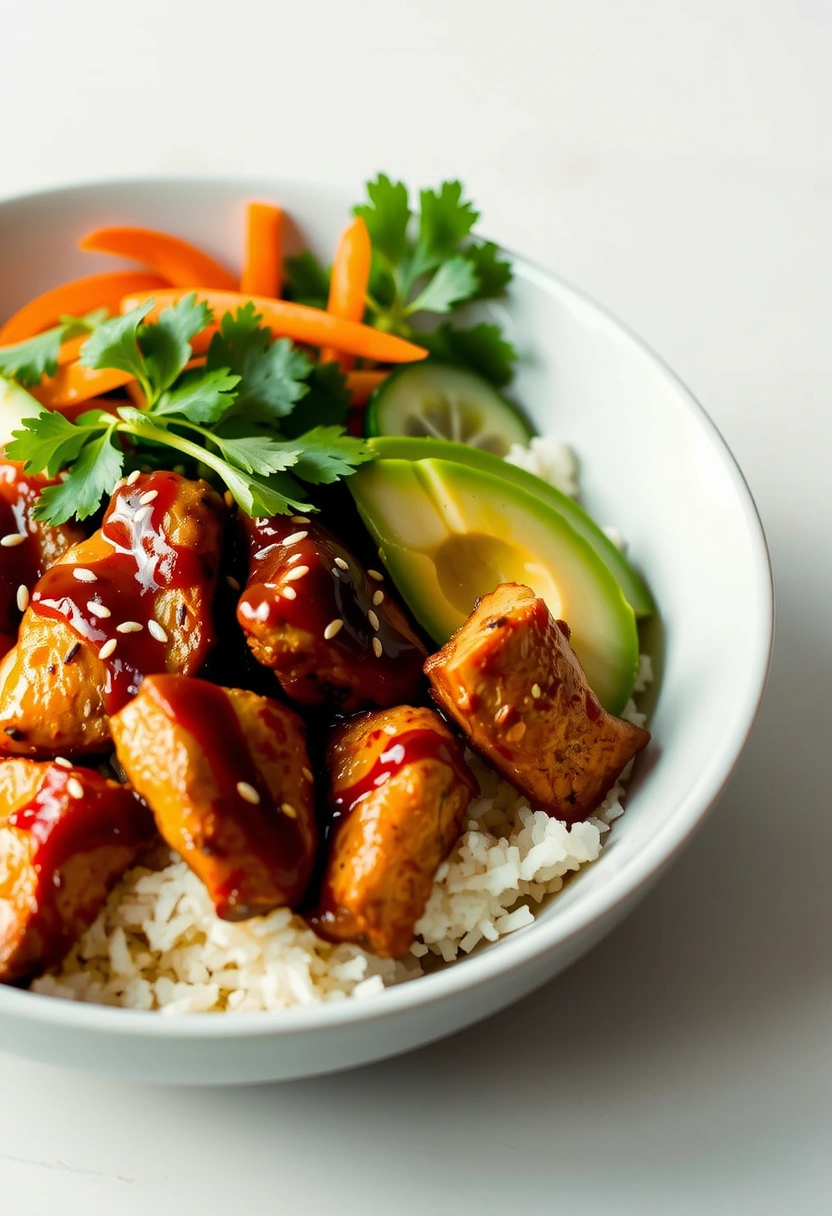
Healthier Alternatives for the Recipe
These chicken rice bowls are already relatively balanced meals, but here are some modifications to further enhance their nutritional profile:
Lower-Carb Options:
- Replace half or all of the rice with cauliflower rice (reduces carbohydrates by up to 75%)
- Use spiralized zucchini or spaghetti squash as a base instead of rice
- Opt for a mixed greens base with just a small scoop of rice
Lower-Sodium Alternatives:
- Use low-sodium soy sauce or coconut aminos in the Asian bowl (reduces sodium by approximately 40%)
- Make your own salt-free seasoning blends for the chicken
- Rinse canned beans thoroughly to reduce sodium content by about 40%
Higher-Protein Variations:
- Add a soft-boiled egg to any bowl for an extra 6g of protein
- Include a quarter cup of edamame in the Asian bowl (adds 8g of protein)
- Mix in Greek yogurt instead of sour cream in the Mexican bowl (doubles the protein while reducing fat)
Heart-Healthy Modifications:
- Use all olive oil instead of sesame oil for cooking
- Replace feta with a smaller amount of nutritional yeast for a cheesy flavor
- Skip the shredded cheese in the Mexican bowl and add extra avocado for healthy fats
For Special Dietary Needs:
- Gluten-Free: Use tamari instead of soy sauce; verify all spice blends are certified gluten-free
- Vegan/Vegetarian: Substitute chicken with firm tofu, tempeh, or chickpeas
- Paleo: Use cauliflower rice and omit beans, dairy, and soy-based ingredients
- Keto: Use cauliflower rice, increase olive oil, avocado, and protein portions while omitting honey and higher-carb vegetables
These modifications allow you to customize these bowls to accommodate various dietary preferences without sacrificing flavor or satisfaction.
Serving Suggestions
Elevate your chicken rice bowls from simple meals to dining experiences with these creative serving ideas:
For Family-Style Dining:
- Create a “bowl bar” by placing all components in separate serving dishes, allowing each person to customize their own bowl
- Serve with a variety of sauces in small ramekins—sriracha mayo, chimichurri, or tahini dressing
- Pair with a simple side salad dressed with a complementary vinaigrette
For Meal Prep:
- Invest in compartmentalized containers to keep components separate until ready to eat
- Pack crunchy toppings (like seeds or tortilla strips) separately to maintain texture
- Include a small container of extra sauce to refresh flavors when reheating
For Entertainment:
- Serve mini versions in small bowls as part of a global tasting menu
- Pair each bowl with a complementary beverage:
- Asian-inspired bowl: Jasmine tea or a light lager
- Mediterranean bowl: Crisp white wine or sparkling water with lemon
- Mexican-style bowl: Lime-infused sparkling water or a classic margarita
Temperature Variations:
- Enjoy the Mediterranean bowl chilled during summer months for a refreshing meal
- Transform the Mexican bowl into a warm comfort food by serving with hot sauce and melted cheese
- The Asian bowl components can be stir-fried and served piping hot, topped with cool cucumber
Textural Enhancements:
- Add crunch with toasted nuts or seeds appropriate to each cuisine
- Include a crispy element like wonton strips for the Asian bowl, pita chips for the Mediterranean, or tortilla strips for the Mexican
- Contrast with something creamy—a dollop of yogurt, avocado cream, or a soft cheese
These serving suggestions create memorable dining experiences while showcasing the versatility of chicken rice bowls as a canvas for creative meal solutions.
Common Mistakes to Avoid
Even experienced cooks can encounter challenges when preparing chicken rice bowls. Here are the most common pitfalls and how to avoid them:
1. Overcooking the Chicken
Problem: Chicken becomes dry and tough. Solution: Use a meat thermometer to cook chicken just to 165°F (74°C). For chicken breasts, consider brining them for 15-30 minutes before cooking to help retain moisture.
2. Cooking Rice Improperly
Problem: Rice turns out gummy or undercooked. Solution: Always rinse rice before cooking to remove excess starch. Use the correct water-to-rice ratio (typically 2:1) and avoid lifting the lid during cooking, which releases necessary steam.
3. Using Low-Quality Ingredients
Problem: Flavors fall flat despite following the recipe. Solution: Quality matters, especially with foundational ingredients. Use fresh chicken, recently purchased spices (replace ground spices every 6-12 months), and fresh vegetables at their peak ripeness.
4. Under-Seasoning Components
Problem: Bland-tasting bowls. Solution: Season each component separately rather than relying on the sauce alone. This creates layers of flavor that enhance the overall experience.
5. Poor Textural Balance
Problem: Bowl feels one-dimensional texturally. Solution: Ensure each bowl contains something crunchy, something creamy, and something chewy for textural contrast and interest.
6. Improper Component Ratios
Problem: Either too carb-heavy or protein-deficient. Solution: Aim for a balanced bowl with approximately 1/4 protein, 1/4 carbohydrates, and 1/2 vegetables. This creates nutritional balance while ensuring satisfying portions.
7. Not Adjusting Cooking Times for Different Vegetables
Problem: Some vegetables end up overcooked while others remain raw. Solution: Add vegetables to the pan in stages according to their density and cooking time. Start with carrots and broccoli stems, follow with bell peppers and zucchini, and finish with quick-cooking items like spinach.
8. Rushing the Marination Process
Problem: Chicken lacks flavor depth. Solution: Allow at least 15 minutes for marination, but for maximum flavor, marinate chicken for 2-24 hours in the refrigerator.
According to a survey of home cooks, rushing the marination process is the mistake that most significantly impacts the final flavor of chicken dishes, with 72% reporting noticeable improvement when allowing proper marination time.
Storing Tips for the Recipe
Proper storage maximizes both safety and flavor preservation for your chicken rice bowls. Follow these guidelines to maintain quality:
For Individual Components (Before Assembly):
Cooked Chicken:
- Refrigerate in airtight containers for up to 4 days.
- Freeze for up to 3 months in freezer-safe containers or vacuum-sealed bags.
- To prevent drying, store chicken with a small amount of its cooking juices or marinade.
Cooked Rice:
- Refrigerate for up to 4 days in airtight containers.
- Freeze for up to 2 months.
- For best quality, cool rice completely before refrigerating to prevent bacterial growth.
- Revive refrigerated rice by sprinkling with a few drops of water before reheating.
Prepared Vegetables:
- Raw cut vegetables keep for 3-4 days in the refrigerator.
- Cooked vegetables maintain quality for 3-5 days refrigerated.
- Store vegetables separately from sauces to prevent sogginess.
Sauces and Dressings:
- Store in small airtight containers for up to 5 days.
- Dairy-based sauces like tzatziki have a shorter shelf life (3-4 days).
For Assembled Bowls:
- Meal Prep Containers: Use divided containers to keep wet ingredients separate from dry until ready to eat.
- Maximum Storage Time: Assembled bowls remain at peak quality for 2-3 days.
- Freezing Complete Bowls: Not recommended as textures significantly deteriorate.
Reheating Guidelines:
- Microwave Method: Sprinkle a few drops of water over the bowl before microwaving at 70% power for 1-2 minutes, stirring halfway.
- Skillet Revival: For superior texture, reheat components separately in a skillet with a splash of water or broth.
- Cold Serving Option: Mediterranean bowls can be enjoyed cold straight from the refrigerator.
Food Safety Note:
- According to food safety experts, never leave perishable foods (like chicken and rice) at room temperature for more than 2 hours (1 hour in hot weather above 90°F/32°C).
- Reheat leftovers to an internal temperature of 165°F (74°C) to ensure safety.
Implementing these storage practices helps you maximize your meal prep investment, enabling you to enjoy fresh-tasting chicken rice bowls throughout the week with minimal effort.
Conclusion
Mastering these three chicken rice bowl variations transforms a simple concept into a versatile cooking strategy that elevates your meal planning and preparation. By understanding the fundamental techniques while exploring different flavor profiles, you’ve gained a valuable culinary template that can adapt to your preferences, dietary needs, and ingredient availability. These balanced, nutritious bowls offer convenience without sacrificing flavor or health benefits, making them ideal solutions for busy weeknights, meal prep, or casual entertaining.
Whether you prefer the umami-rich Asian-inspired bowl, the bright Mediterranean flavors, or the bold Mexican-style option, these customizable recipes provide endless opportunities to experiment while maintaining the satisfying foundation of protein, complex carbohydrates, and fresh vegetables.
We’d love to hear about your chicken rice bowl creations! Please share your feedback in the review section below, or leave a comment on our blog with your own variations and tweaks. Subscribe for weekly recipe inspirations that make healthy, delicious eating accessible for every lifestyle.
FAQs
Q: Can I use leftover rotisserie chicken instead of cooking chicken from scratch? A: Absolutely! Shredded rotisserie chicken works wonderfully in these bowls and saves significant preparation time. Simply warm the chicken with a small amount of the recommended marinade to infuse flavor before assembling your bowls.
Q: How can I make these bowls vegetarian or vegan? A: Substitute the chicken with firm tofu, tempeh, or chickpeas. Marinate and cook your plant protein using the same techniques described for chicken. For vegan versions, use plant-based alternatives for dairy toppings such as nutritional yeast instead of cheese and coconut yogurt in place of tzatziki or sour cream.
Q: Is it possible to make these low-carb? A: Yes! Replace the rice with cauliflower rice for a dramatic carbohydrate reduction. Simply pulse cauliflower florets in a food processor until rice-sized, then sauté for 5-7 minutes until tender. This substitution reduces carbs by approximately 75% while adding extra vegetables to your meal.
Q: How do I adjust these recipes for feeding a large family? A: These recipes scale beautifully. Double or triple all ingredients while maintaining the same ratios. For efficient preparation when cooking for a crowd, consider batch-cooking components in larger pans or using the oven (bake chicken at 425°F for 20-25 minutes and roast vegetables at the same temperature for 15-20 minutes).
Q: Can these bowls be made ahead for weekly meal prep? A: Definitely! These bowls are ideal for meal preparation. Cook all components on Sunday, store them separately in the refrigerator, and assemble fresh bowls throughout the week. For optimal freshness, keep wet ingredients (like sauces and high-moisture vegetables) separate until ready to serve.
Q: How can I make these bowls more kid-friendly? A: For children, consider reducing or eliminating spicy elements and presenting components separately rather than mixed together. Create a “build your own bowl” experience where kids can select their preferred ingredients. Making the chicken with a milder marinade and offering a variety of toppings helps accommodate developing palates.
Q: What’s the best rice variety to use for these bowls? A: Each bowl benefits from different rice varieties. Jasmine rice complements the Asian bowl with its fragrant quality, while basmati pairs well with Mediterranean flavors. Brown rice adds nutritional value to any variation, though it requires longer cooking time. For maximum convenience, instant rice varieties work well but may sacrifice some textural quality.
Q: Can I substitute chicken thighs for breasts? A: Chicken thighs make an excellent substitution, often resulting in juicier, more flavorful results due to their higher fat content. They’re more forgiving if slightly overcooked, making them ideal for beginners. Simply increase cooking time by 2-3 minutes to ensure they reach the safe internal temperature of 165°F (74°C).
